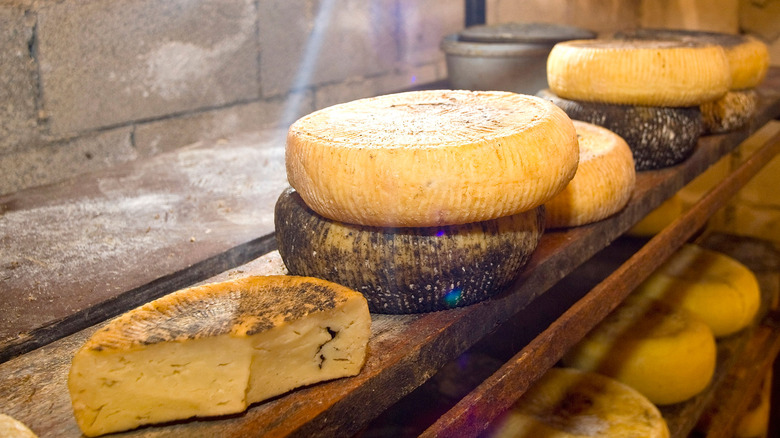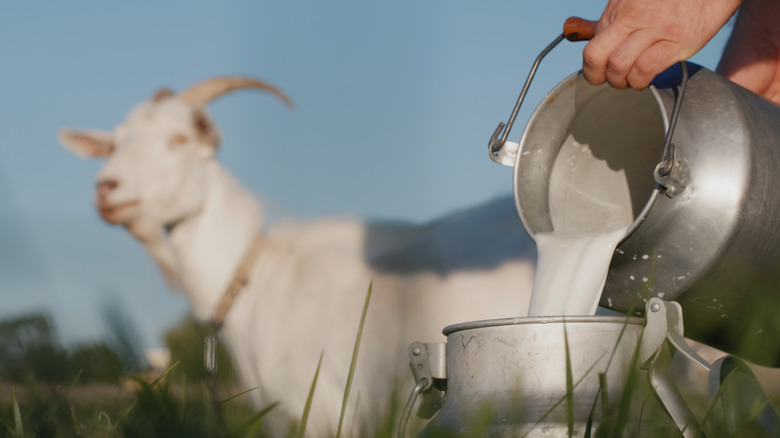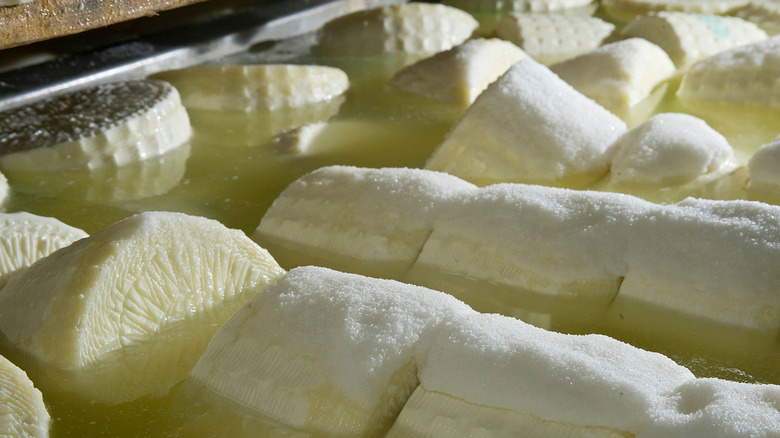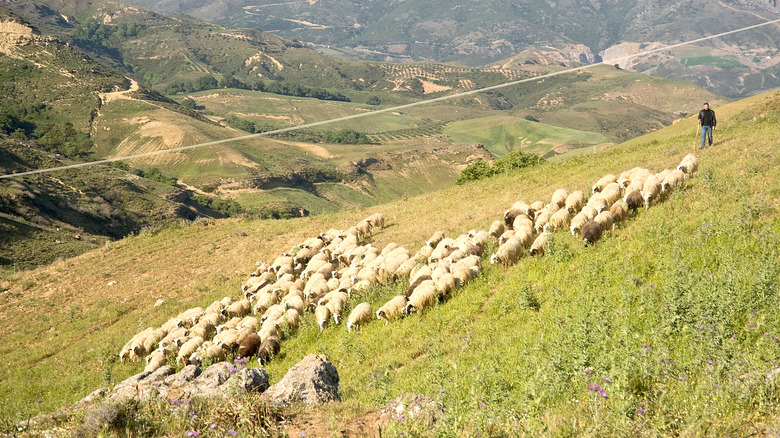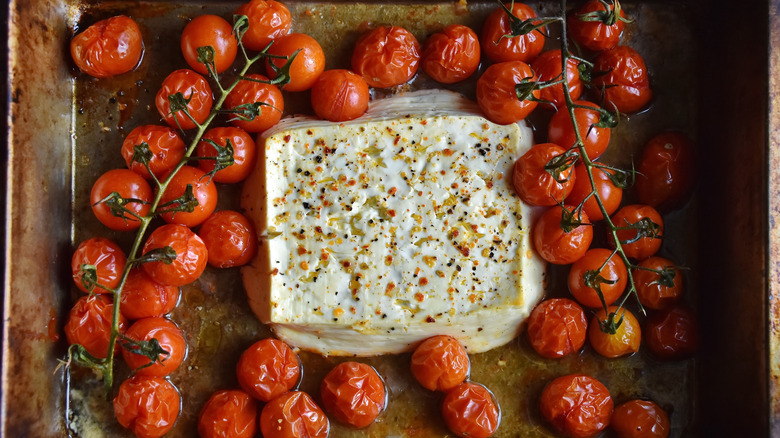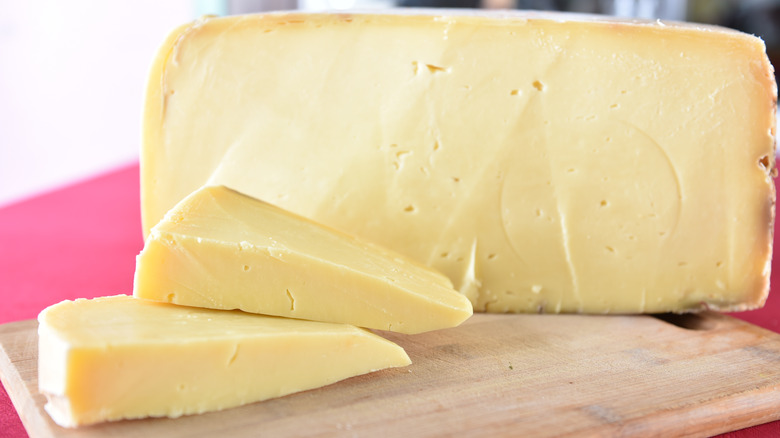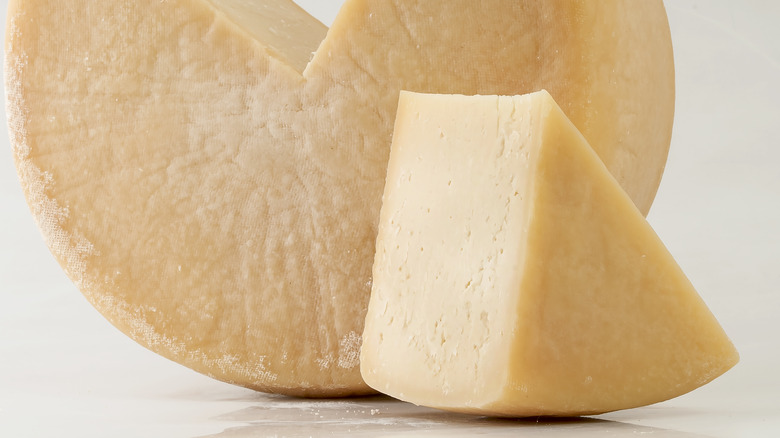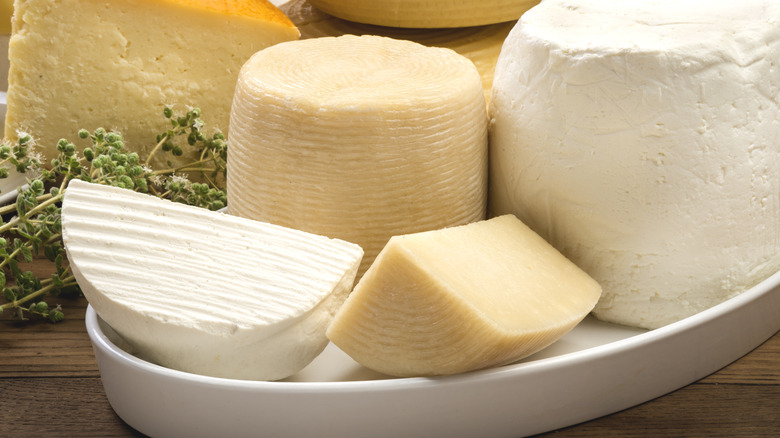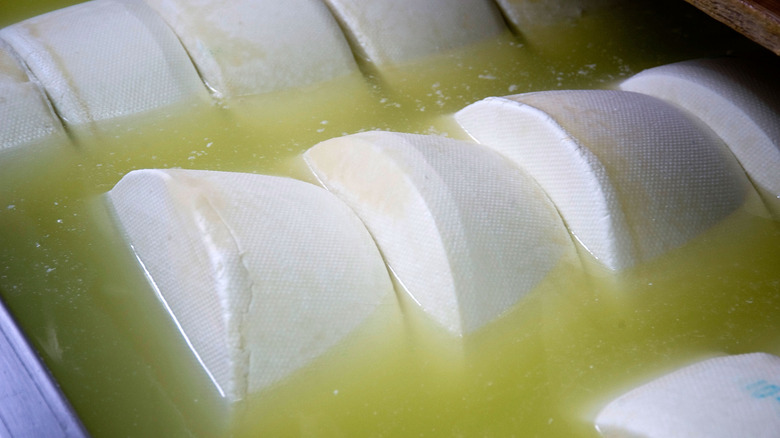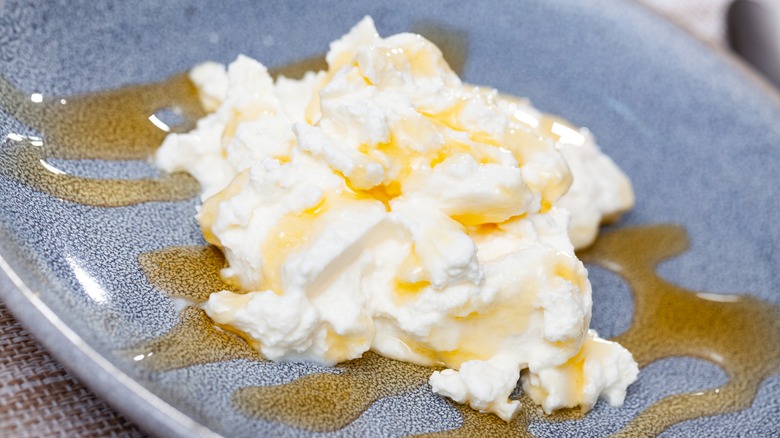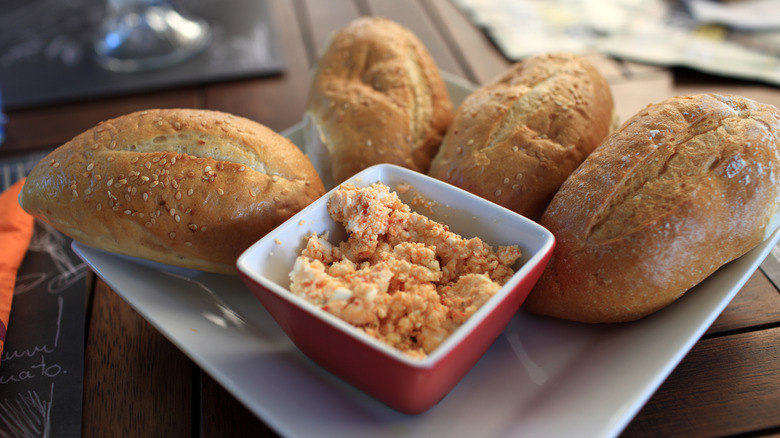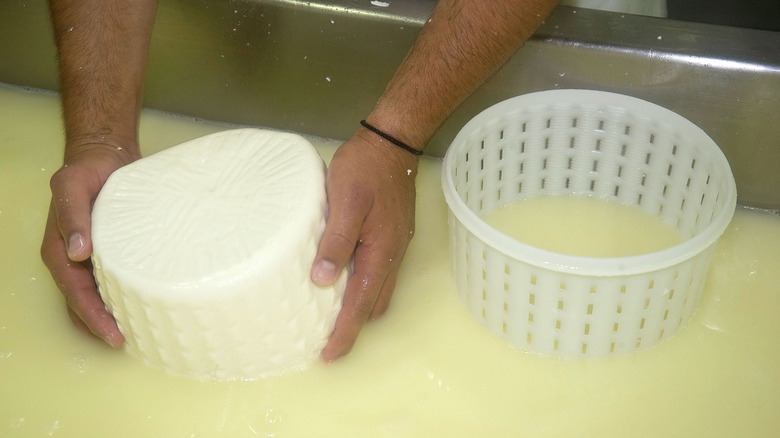Everything You Need To Know About The World Of Greek Cheese
Feta is the most recognized Greek cheese, and with baked feta pasta recipes going viral in 2020, its popularity only continues to explode. It's no wonder, given the unique crumbly yet smooth texture and soft yet sharp taste, that it's a salad staple worldwide. While its origins and flavor are fascinating, there is much more depth to the world of Greek cheese than just our flagship favorite, feta.
For ancient Greeks, cheese was a sacred food and, as we can all agree, continues to be. Although Greek cheeses share distinguishing regional traits, they also vary greatly in mouthfeel, flavor, aroma, and appearance. Modern developments have altered the way some of these salty delicacies are produced, but there is currently protection in place for some of Greece's most distinguished and loved varieties. Unless you're a cheesemonger or from Greece, it's likely you've never tried or even heard of many of the varieties popular to locals. Grab your cheese knives and charcuterie boards, because your palate is about to expand.
The first recorded mention of cheese
Cheese-making has been a staple of Greek culture for thousands of years. It's believed that over 8,000 years ago, cheese was accidentally invented in Greece during the transport and storage of milk in animal stomach containers, per the National Historic Cheese Making Center. It's believed that either the natural resin found in the stomach lining, or a preservative such as salt, curdled the milk to produce the first-ever curds and whey. This discovery lead to the very first version of what would come to be known as feta cheese.
Although this origin story cannot be confirmed, there are pieces of historical evidence that support such speculations. Ancient Greek works produced by Aristoteles, Pythagoras, and others contain mentions of cheese and cheesemaking that date back to ancient times. The first recognized mention, however, can be found in Homer's classic, "The Odyssey," which is thought to be written in the 7th or 8th century B.C.E., as claimed by The British Museum. During his escape from the cyclops Polyphemus's cave, our protagonist Odysseus grabs some cheese, made by the cyclops, on his way out.
Greek mythology is fraught with cheesemaking
While Homer's mention is the oldest known record of cheese, plenty of other ancient Greek texts mention the fermented delicacy, per the European Commission.
The untold truth of feta's origin is that Aristaeus, son of Apollo, learned his mastery of cheesemaking and shepherding from the Nymphs. He then taught those dwelling in the countryside to shepherd flocks, press olive oil, and then curdle milk with rennet to make cheese. Legends found in ancient poetry tell the story of Aristaeus, titled the god of shepherds, beekeeping, and cheesemaking, and how he was brought to the island of Naxos by Apollo. He was left there to teach the Islanders the art of cheesemaking, which is a local tradition to this day, as recounted by Culture: The World on Cheese and Theoi and Greek Mythology.
Because Greek's cheesemaking industry is so fraught with history and mythological ties, it's no wonder many of the original traits of ancient Greek cheesemaking are applied to modern production.
Distinguishing traits
Traditionally, Greek cheese has been made by shepherds with sheep and goat's milk. This gives Greek cheese a distinguished sharp aftertaste. Varying from the most common varieties of cheese from around the world, most Greek cheese contains no or very little cow's milk. In fact, sheep and goats continue to dominate the country's dairy production to this day, per SUFISA.
Much of the unique flavors of the islands' cheeses are thought to be linked to the herbs, plants, and grasses that grow there. It's traditional for sheep and goats to be grass-fed, which produces a unique flavor, and nutritional infusion. Some varieties of cheese are renowned for their fluctuating flavor profiles, dependent on the seasonally changing flora of the island they grow on.
Co-founder of Greek Flavours and Greek food expert, Emanuele Bettuzzi described Greece to us as "the cradle of Mediterranean cuisine, where one of the oldest versions of the Mediterranean diet was born." He explains the reason being that "the Greek territory, due to its position and climate, is naturally rich in the production of exceptional raw materials. Just think of the microclimates that occur in some areas of the Peloponnese as well as on the island of Crete, where winter almost does not exist." Bettuzzi goes on to explain that although distinct, Greek cheese varies greatly in flavor and production methods.
The production process
Cheese flavor, nutrient content, density, and texture rely on many factors, including the animal of origin and what they are fed, the fermentation and aging process, and finally preservation techniques. Many Greek kinds of cheese forego the pasteurization process, including the ever-so-popular Kasseri, to preserve some of the stronger flavors caused by the natural bacteria growth. Next, rennet or starter cultures are added to form curd which is then heated and separated from the whey. From there, the curd is processed and formed to create cheese, which can be preserved using a variety of methods, per ResearchGate.
While some varieties like feta are preserved in brine, others like Ladotyri Mytilini are stored in olive oil. Emanuele Bettuzzi recalls, after receiving an invitation to a village in the mountains of central Peloponnese, enjoyed a variety of feta that was preserved in a yogurt-based sauce.
By varying each step of the process both flavor and texture can be altered to create different varieties of cheese. Bettuzzi explains that although Greek cheese may vary by recipe, it is "distinguished by its strong and powerful penetration into rural life."
Although traditional methods are still widely in use today, the introduction of cow's milk and new technologies have changed the way the Greeks make cheese. Luckily, there is protection in place to preserve some of Greece's favorite cheese varieties.
Many Greek cheeses are protected
Because cheese is such an important historical and culinary staple, many of the historically designed cheeses are part of the Protected Designation of Origin and labeled PDO cheeses, notes the European Commission. PDO status is given only to products that are strongly linked to their area of origin and must follow a set of protocols during the production process.
PDO designation indicates that the food in question must be produced and grown entirely in the specified region. For example, San Marzano tomatoes must be grown in the Agro Sarnese Nocerino region of Italy. In the same light, San Michali cheese must be produced on the island of Syros, Greece. That means the livestock must originate from the island, and graze locally. Certain chemicals and additives are banned from all PDO production. This way, when a consumer purchases a product, they know it is verified as authentic, per the European Commission. Just look for the PDO stamp to confirm it's from a protected producer.
Feta
Feta is the oldest cheese in recorded history, per the Greek Reporter, and remains an international favorite. It's commonly used and easily found outside of Greece. PDO Feta, however, only comes from Macedonia, Epirus, Sterea Ellada, Thrace, Thessaly, Peloponnesus, Lesvos, Limnos, and Agios Efstratios.
Many Greek dishes feature the crumbly white cheese, including Greek's flagship savory pastry, the traditional spanakopita. This semi-soft white cheese is fresh yet sharp with a tang produced by the goat and/or sheep's milk and is stored in a salty brine that can preserve it for months. Emanuele Bettuzzi describes a variety, feta barelisia, that is aged in wooden barrels, giving it "an exquisite slightly spicy taste, unique of its kind."
For legal reasons, exported feta is often pasteurized, but many local farmers continue to produce it the original way, without pasteurization, which gives it a slightly more intense flavor. Modern feta production sometimes includes the addition of cow's milk, although many Greeks stick to the ancient production methods using only sheep and goat's milk, again, giving the cheese a sharper flavor, as described by Britannica. PDO feta cheese is made without any added cow's milk and can contain no more than 30% goat's milk.
Kasseri
Kasseri is a PDO cheese when produced using unpasteurized sheep milk (but up to 10% goat's milk can be added) on the islands and regions of Lesbos, Thessaly, Macedonia, and Xanthi. It's often used as a table cheese because of its buttery texture and salty and creamy flavor. It has a strong odor and springy feel and can be found in sandwiches, omelets, and paired with pastries, per Cheese.com. Kasseri melts beautifully and should be considered for making the perfect grilled cheese sandwich.
To bring out the natural aroma and flavors, kasseri is best eaten when at room temperature or paired with hot bread. It takes about three months to mature, but like fine wine, it gets better with age. Speaking of wine, Kasseri pairs beautifully with a glass of dry white or mild red because of its subtle flavors and salty notes. Emanuele Bettuzzi enjoys this variety with olives and herring while sipping a glass of tsipouro, a Greek spirit, with ice.
San Michali
This PDO cheese is produced exclusively on the Island of Syros and is the only protected cheese that uses entirely cow's milk, says Au Gourmet Grec. This cheese wasn't produced until the '70s but is considered a traditional Greek cheese. Although San Michali has one of the more expensive cheeses produced in the country and has currently just two producers on the Island, it's expensive because production is limited due to the large quantity of milk it takes to produce each wheel — about 10 pounds of milk for each kilo of cheese, per Au Gourmet Grec.
San Michali can be recognized for its unique spicy and nutty flavors, and even contains detectable notes of flora local to the island. With a hard yellow exterior, the interior contains small irregular holes and has a crumbly texture. Much like Kasseri, San Michali can be used as a table cheese and is quite complex when eaten on its own. It is often added to omelets and soufflés, as well.
Ladotyri Mytilinis
"Ladotyri Mytilinis" translates to "oil cheese" because this unique PDO cheese is preserved in olive oil, says Taste Atlas. This spicy cheese is made exclusively from sheep and goats milk local to Lesbos, which has thriving livestock, olive oil, and cheesemaking industries. In fact, Lesbos is one of the top producers of olive oil in the country, so it's no surprise that it's a go-to preservation method for locals.
This variety is hard, which prevents too much oil absorption during storage. Although gentle in flavor, Ladotyri Mytilinis holds its own and complements nicely the floral complexities of the olive oil. Made primarily from sheep's milk, this must-try unique cheese can contain up to 30% goat's milk, but no cow's milk, per Greek Boston. Emanuele Bettuzzi enjoys this hard variety on the grill or fried in saganaki, because of its solid texture.
Typically, Ladotyri Mytilinis is used in recipes local to Lesbos, but can be paired beautifully with a sweet wine because of its salty finish.
Graviera
Graviera sounds a bit like "gruyere" because it was first produced in Greece in 1914 based on the classic Swiss-made cheese. Although gruyere is typically made with cow's milk, this Greek spinoff uses sheep and goat's milk, making it distinguishable and unique to the region. Livestock local to Graviera Agrafon, Graviera Kritis, and Graviera Naxos, is responsible for its varying flavor, as graviera can be found in both sweet and spicy varieties, per Euro Food Quality S.A. Although the listed regions are used for PDO graviera, other Greek regions produce the cheese without the PDO label.
This cheese is popular only second to feta in Greece, and because of its variance of flavor can fit almost any palate or pairing. When aged passed five months, graviera starts to lose its sweet undertones and gains a sharp spiciness as described by Ambrosia. Emanuele Bettuzzi explains, "In addition to the classical traditional Graviera there are, for example, the exquisite Graviera with pepper and the spicy version with chili." Bettuzzi goes on to compare a version of aged graviera naxou to the famous parmigiano reggiano.
Manouri
Feta is a high-demand cheese with mass demand for exports. During the feta-making process, excess whey is saved and used to make manouri, says Cheese.com. Subsequently, this variety of Greek cheese is made entirely from sheep and goat's milk. Although manouri is made from leftover feta whey, it has its unique production process and flavor.
Manouri holds its PDO status in Western and Central Macedonia and Thessaly. It is creamy, soft, and white like feta, but has a greasier and grainier texture. While feta is known for its salty notes, manouri, sometimes referred to as "manoypi," has a citrus undertone that distinguishes it greatly from its predecessor. Like feta, manouri doesn't have a casing, and like goat cheese, it can be found in roles or logs. This spreadable Greek cheese is It's sweet and rich in flavor, and can be paired with honey, dried fruit, and can be used as a substitute for Greek yogurt, per Cheese.com.
Kopanisti
Kopanisti is a PDO moldy, strong, and spicy cheese that varies in flavor depending on the season the sheep and goats are grazing. This is because of the variety of flora on the Cycladic Islands where the cheese is produced and holds PDO status. It's been produced on Mykonos for over 300 years and is a popular pick among locals. Notes of local herbs and grasses can be detected in the undertones of this unique Greek cheese. Emanuele Bettuzzi describes the variety as, "a cream with a spicy and slightly acidic flavor, which goes perfectly with grilled meat."
Much like blue cheese or gorgonzola, this light pink cheese contains layers of fungal growth that produce a strong flavor and aroma. The superficial bacteria, such as penicillium and lactobacilli develop during the fermentation process. Because it can last for many months without refrigeration, it is popular among Mediterranean sailors, per the Slow Food Foundation for Biodiversity.
Anthotyro
While it doesn't hold PDO status, anthotyro is of Greek origin and has been produced for centuries in regions of Macedonia, Thrace, Peloponissos, Crete, Thessalia, and Epirus, says Taste Atlas. It's distinguished by its production process, which includes adding whey to sheep or goat's milk. "Anthotyro" which translates to "flower cheese" gets its name from the strong floral and herbal aromas.
Although this salty and tangy Greek cheese has a crumbly texture, when aged for an extended period of time, it can be grated over pasta or salads. Both versions are distinct in flavor, but their production process is almost identical. The fresh version carries a milder flavor, while the dry version is known for rich and salty undertones, according to Taste Atlas.
The soft version is often paired with dried fruits and honey, while the dry version is customarily used as a table cheese, and couples nicely with a creamy pasta dish.
Kefalotyri
Although not PDO, this tangy yellow cheese dates back to the Byzantine era and is most commonly produced in Greece and Cyprus. It only takes a few months to ripen, yet its flavor is strong and distinct with sharp and salty undertones, mimicking those of a traditionally longer-aged cheese, per MasterClass. After extended aging, the Greek cheese continues to sharpen in flavor, and harden. The dry version, like Anthotyro, can be used grated over pasta or salads.
Typically, fresh kefalotyri is served with appetizers and pairs nicely with red wine because of its intense flavor. Another popular and traditional dish using this distinct cheese is saganaki, which is the epitome of every cheese-lovers dream: cheese fried in olive oil. Yes, you heard me correctly. Just toss a thick slice of kefalotyri in a little flower, and add it to a hot pan with olive oil. Used in a variety of ways, kefalotyri is a top pick amongst those who appreciate intense, sharp, and tangy cheese.
